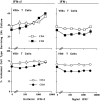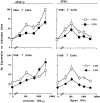Type I interferons keep activated T cells alive
- PMID: 9927514
- PMCID: PMC2192920
- DOI: 10.1084/jem.189.3.521
Type I interferons keep activated T cells alive
Abstract
Antigen injection into animals causes antigen-specific T cells to become activated and, rapidly thereafter, die. This antigen-induced death is inhibited by inflammation. To find out how inflammation has this effect, various cytokines were tested for their ability to interfere with the rapid death of activated T cells. T cells were activated in vivo, isolated, and cultured with the test reagents. Two groups of cytokines were active, members of the interleukin 2 family and the interferons (IFNs) alpha and beta. This activity of IFN-alpha/beta has not been described previously. It was due to direct effects of the IFNs on the T cells and was not mediated by induction of a second cytokine such as interleukin 15. IFN-gamma did not slow the death of activated T cells, and therefore the activity of IFN-alpha/beta was not mediated only by activation of Stat 1, a protein that is affected by both classes of IFN. IFN-alpha/beta did not raise the levels of Bcl-2 or Bcl-XL in T cells. Therefore, their activity was distinct from that of members of the interleukin 2 family or CD28 engagement. Since IFN-alpha/beta are very efficiently generated in response to viral and bacterial infections, these molecules may be among the signals that the immune system uses to prevent activated T cell death during infections.
Figures





References
-
- Webb S, Morris C, Sprent J. Extrathymic tolerance of mature T cells: clonal elimination as a consequence of immunity. Cell. 1990;63:1249–1256. - PubMed
-
- Kawabe Y, Ochi A. Programmed cell death and extrathymic reduction of Vβ8+ CD4+ cells in mice tolerant to Staphylococcus aureusenterotoxin B. Nature. 1991;349:245–248. - PubMed
-
- McCormack JE, Callahan JE, Kappler J, Marrack P. Profound deletion of mature T cells in vivo by chronic exposure to exogenous superantigen. J Immunol. 1993;150:3785–3792. - PubMed
-
- Kearney ER, Pape KA, Loh DY, Jenkins MK. Visualization of peptide-specific immunity and peripheral tolerance induction in vivo. Immunity. 1994;1:327–339. - PubMed
-
- Duke RC. IL-2 addiction: withdrawal of growth factor activates a suicide program in dependent T cells. Lymphokine Res. 1986;5:289–299. - PubMed
Publication types
MeSH terms
Substances
Grants and funding
LinkOut - more resources
Full Text Sources
Other Literature Sources
Research Materials

